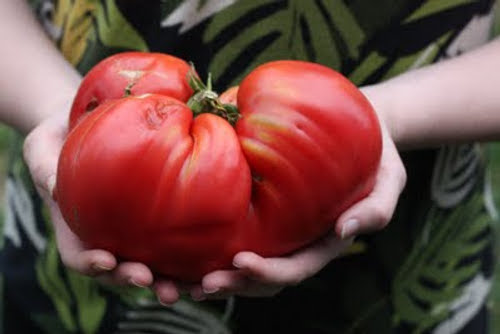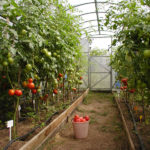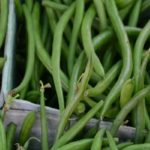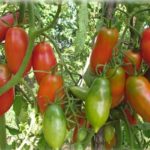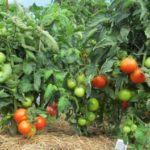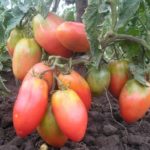The Monomakh Cap tomato was selected in Russia. In 2003, it was included in the State Register of Breeding Achievements. When breeding it, breeders took into account the unstable Russian weather.
Description of the variety
Characteristics and description of the variety: the tomato is classified as a mid-early variety, that is, 90–110 days pass from the first sprouts to the harvest of tomatoes. This is an indeterminate standard variety. Bushes are 1 – 1.5 m high.The tomatoes are very large, pinkish, and after ripening scarlet, on average their weight is 0.5 - 0.8 kg, but the fruits can be up to 1 kg. Round in shape, slightly flattened on the sides.
With careful care of the site, you can collect up to 6 - 8 kg per bush. From 1 m² of plantings, 18 - 20 kg are collected. In the greenhouse, 16 - 18 kg per 1 m² is collected. Tomatoes contain 4–6% dry matter. Seedlings are grown both in greenhouses and in open ground.
Advantages and disadvantages
The advantages of the variety include:
- large tomatoes;
- excellent taste;
- the variety is immune to late blight and some viral diseases;
- high productivity;
- drought-resistant;
- Tomatoes have a strong peel - ripe fruits are quite strong, so they are stored for a long time;
- the crop ripens at the same time;
- the fruits are transportable.
Features of use: tomatoes can be eaten fresh, squeezed juice, made paste. But the variety is not suitable for canning due to its large size.
Since tomatoes are large and heavy, the branches often break and they need to be tied up well.
Sowing seeds
Cultivation begins with sowing seeds: sown 60 days before transplanting seedlings into open ground or a greenhouse.
Buy seeds in well-known stores, beware of purchasing packages from unknown dubious companies.
Planting seedlings and caring for them
Tomatoes do not like soil that has acidic properties - if they are planted in such soil, the bushes will wither. To reduce acidity, fluff lime and dolomite flour are poured into the ground when digging. Seedlings are planted in the ground before flowering.
When planting seedlings, dig holes, making a space of 50 cm between holes, and 60 cm between rows. Plant up to 6 plants per 1 m².
Top dressing
When the tomatoes in the upper clusters become full and weigh 100 g, feed the bushes with potassium nitrate. With such feeding tomatoes will not develop blossom end rot and will not crack.
Weed control
Don't pull out the weeds - just cut them with a flat cutter several times over time and let the roots rot in the ground. Place weed clippings between the rows. It is recommended to put earthworms in the mulch and cover them with chopped grass on top.
Watering
You cannot water this variety along the furrows you have made. Tomatoes love water very much, so water the bushes very generously at the roots, so that the water penetrates two shovels deep into the ground. Then you will get a big harvest.
Removing stepsons, barren flowers, pinching
Be sure to cut off the stepsons. Each sprout usually grows 3 trunks, tear off two of them. After planting the seedlings, tie up each bush.
To form a harvest, remove small flowers; when flowering, shake the plant so that it is pollinated. If you planted tomatoes in a greenhouse, do not forget to ventilate the room. After pollination, water the bushes, then the pollen will germinate.
The first bud that opens is always terry and must be picked. Leave 2 ovaries on the first brush, tear off the rest.
Since the plant is classified as an indeterminate variety, the bush does not stop growing upward, as a result, there will be ovaries on the bush in late autumn. The bushes grow tall and grow very quickly. When the plants are 1 m tall, pinch the tops off.
If, due to autumn rainy weather, you are forced to collect tomatoes ahead of time, then collect the brownish fruits - they have a good taste, and if you leave the tomatoes in the rain, the fruits will begin to crack.
Diseases and pests
Tomato fruits may crack, especially when ripe. To prevent this from happening, reduce watering and apply fertilizer based on nitrate.
Tomatoes can be attacked by wireworms - the larvae of click beetles. You can collect them by hand or cut a piece of the vegetable, prick it on a wooden stick, bury the piece in the soil to a depth of 10 - 15 cm. Leave the end of the stick off the surface. After 3–4 days, remove the piece along with the insects. Burn the wireworms. You can spray your plantings with Baduzan.
If tomatoes are attacked by rusty mites, spray the bushes with Zubr.
A few reviews about the variety
Elina S., 48 years old, Angarsk:
“My husband has been planting tomatoes of the Monomakh Hat variety for 3 years in a row. I found that I grew the most fruits at almost the same temperatures day and night. That year, when the summer was warm, we collected 5 kg of fruit from each bush. They make excellent salads and sauces, as the tomatoes are sweet and juicy. Be sure to remove the stepsons when growing.”
Polina A., 24 years old, Volgograd:
Until recently, we grew Sugar Giant and Grandma's Secret tomatoes. But a neighbor gave us the seeds of the Monomakh's Cap tomato, and I planted it. I would like to give advice to those who have not yet grown this variety: pick off the stepsons when the bushes are still very small. In addition, tomatoes have a lot of empty flowers, I select them and pick them off. Usually the most growth grows on the first lower hand. large tomatoes. The fruits themselves are sugary and tender. They have thin skin that can crack. The weight of each tomato is 360 - 600 g. I have never grown larger fruits. Bushes up to 1.2 - 1.3 m in height.
Summary
Reviews about tomatoes are positive; all gardeners really like large, sweet and sour tomatoes; a large number of fruits are collected from the bushes.The variety is resistant to common tomato diseases.

